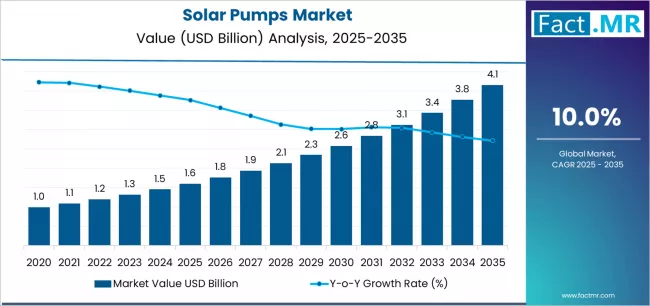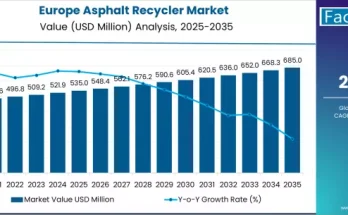The solar pumps market is witnessing remarkable growth as industries, agriculture, and communities worldwide increasingly adopt renewable energy solutions. Solar pumps, which utilize solar energy to operate water pumping systems, are emerging as a cost-effective, eco-friendly, and sustainable solution for irrigation, livestock, water supply, and industrial applications.
The growing focus on renewable energy, rising electricity costs, and the need for reliable water management in remote and off-grid areas are driving adoption of solar pumping systems. These pumps are transforming water accessibility, particularly in agriculture-dependent regions, by providing consistent, low-maintenance, and energy-efficient solutions.
Market Overview
Solar pumps are designed to convert solar energy into mechanical energy to drive water pumps, eliminating the need for grid electricity or diesel-powered systems. They are available in various types, including submersible, surface, and centrifugal pumps, each tailored to different applications and water requirements.
The market is driven by technological advancements such as high-efficiency solar panels, smart controllers, and battery integration, which optimize performance and allow for operation even in variable sunlight conditions. Manufacturers are focusing on durable, corrosion-resistant materials, modular designs, and scalable systems that cater to small-scale farms, large irrigation projects, and municipal water supply.
With sustainability becoming a global priority, solar pumps align with environmental goals by reducing carbon emissions, lowering energy costs, and minimizing reliance on fossil fuels. Their deployment supports renewable energy initiatives, agricultural productivity, and water conservation efforts, making them a preferred choice in both rural and urban applications.
Regional Insights
North America
North America is witnessing growing adoption of solar pumps due to increasing awareness of renewable energy, government incentives, and sustainable agriculture initiatives. Solar pumps are being deployed in farms, residential water supply systems, and municipal projects, supporting both environmental and economic objectives.
Europe
Europe emphasizes eco-friendly irrigation and water management solutions. Stringent environmental regulations, renewable energy subsidies, and the transition to sustainable agricultural practices drive the adoption of solar pumps across the region. Technological innovation and smart water management systems further enhance market growth.
Asia-Pacific
Asia-Pacific represents a high-growth region due to its dependence on agriculture, rural water scarcity issues, and renewable energy initiatives. Countries in this region are increasingly implementing solar-powered irrigation systems to improve water efficiency, support smallholder farmers, and reduce electricity costs in remote areas.
Rest of the World
Latin America, the Middle East, and Africa are gradually adopting solar pump technologies to address water supply challenges in off-grid and arid regions. Government-led renewable energy programs, infrastructure development, and sustainable agriculture projects are driving market penetration in these regions.
Key Trends & Forecast
- Technological Advancements in Solar Pumping Systems
Manufacturers are integrating high-efficiency solar panels, smart controllers, and monitoring systems to improve pump performance and energy utilization. Innovations in battery storage also enable consistent operation during cloudy days or nighttime conditions. - Shift Toward Sustainable and Eco-Friendly Solutions
Environmental concerns and rising energy costs are encouraging the use of solar-powered pumps as an alternative to diesel or grid-dependent systems. Solar pumps offer long-term sustainability, reduced carbon footprint, and lower operational costs. - Integration with Smart Irrigation Systems
Solar pumps are increasingly connected with IoT-enabled irrigation systems to optimize water use, monitor soil moisture, and automate irrigation schedules. This trend improves crop yield, water conservation, and energy efficiency. - Government Support and Incentive Programs
Subsidies, renewable energy initiatives, and funding programs are encouraging the adoption of solar pumps in agriculture, municipal water supply, and industrial sectors. Such support facilitates large-scale deployment, especially in rural and off-grid areas. - Customization and Scalable Solutions
End users are demanding solar pumps tailored to specific water needs, crop types, and farm sizes. Manufacturers are responding with modular and scalable solutions suitable for small farms, large plantations, and municipal projects.
Applications & End-Use Outlook
Solar pumps find application across multiple sectors due to their energy efficiency, reliability, and low operating costs:
- Agriculture: Solar pumps support irrigation for crops, orchards, and plantations, reducing dependence on grid electricity and diesel engines. They help maintain soil moisture levels, improve crop yield, and enable year-round irrigation.
- Livestock and Aquaculture: Solar pumps supply water to livestock farms and aquaculture operations, ensuring a consistent water source and supporting operational sustainability.
- Residential and Municipal Water Supply: In remote or off-grid areas, solar pumps provide clean and reliable water supply for households, schools, and community centers.
- Industrial Applications: Solar-powered water pumping systems are used for industrial cooling, processing, and cleaning applications, reducing operational costs and environmental impact.
By integrating with smart water management and monitoring systems, solar pumps enable optimized water usage, efficient energy management, and reduced operational downtime across all applications.
Challenges and Opportunities
Challenges in the solar pumps market include high initial capital investment, dependency on solar irradiance, and limited technical awareness in some rural regions. Maintenance requirements, although minimal, and regional regulatory variations may also impact adoption rates.
However, opportunities for growth are substantial. Technological innovations such as hybrid solar-diesel pumps, AI-enabled irrigation, and advanced energy storage expand market potential. Increasing government support, environmental sustainability initiatives, and rising awareness about energy-efficient water solutions create a favorable environment for market expansion. Emerging economies with large agricultural bases and water scarcity issues represent significant opportunities for market growth.
Conclusion
The solar pumps market is transforming water management and irrigation practices across the globe by providing sustainable, energy-efficient, and reliable solutions. As industries, agriculture, and municipalities adopt renewable energy solutions, solar pumps are becoming critical tools for ensuring water accessibility, operational efficiency, and environmental sustainability.
Technological advancements, smart integration, and supportive government policies are driving widespread adoption. Solar pumps not only optimize water usage and reduce energy costs but also contribute to environmental conservation and sustainable development. By investing in solar-powered pumping solutions, stakeholders can enhance productivity, reduce dependency on conventional energy sources, and promote a greener, more resilient water management ecosystem.
Browse Full Report – https://www.factmr.com/report/4609/solar-pumps-market



